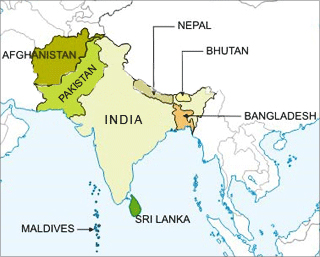
By Luciane Noronha M. de Oliveira
During the 2013 pre-general elections rallies, foreign policy was not one of the main topics for Narendra Modi. However, after nearly 5 years of tenure, it is safe to say that he was one of the most important prime ministers of India’s post-independente period when it comes to global affairs. The perception of a gap in the foreign policy agenda during electoral campaigns soon proved itself wrong, and Modi managed to become one of the world’s most influentional leaders. New Delhi managed to stenghten its ties with the Americas and Europe and bolstered its presence and policies towards Africa and the Asia-Pacific regions.
Yet, India’s regional security environment did not significantly improve in the last five years. Between 2014 and 2015, Modi made efforts towards improving India’s confidence among SAARC countries. During the 18th SAARC meeting held in Kathmandu (2014), South Asian leaders showed optimism regarding what seemed to be New Delhi’s “new” regional approach. By emphasizing peace, prosperity and conectivity as common interests among neighbors, Modi sent a conciliatory message back then.
Despite the ongoing conflict in Kashmir, Indo-pakistani relations also seemed to be somewhat improving. In later 2015, the Indian prime minister made a surprise visit to Islamabad and met his former counterpart, Nawaz Sharif. The unexpected gesture lighted a spark of hope in international media about the possibility of dialogue between both countries. But just as it happened several times throughout India’s post-independente history, the optimism would not last long and the regional environment would soon again take a downturn.
By 2016, South Asian countries would grow suspicious over India’s actions towards them. The first country was Nepal, which elected a Communist Party leader after controversial polls which resulted in the pro-India groups’ defeat and the subsequent economic blockade imposed by New Delhi. This move was seen as external interference and the relations between both countries deteriorated.
China ended up being the big winner, as Nepal broke the monopoly of Indian companies in several strategic sectors and opened up for more Chinese investments in energy and infrastructure projects. India’s relations with Bangladesh, Sri Lanka and Maldives were also damaged as these countries accused New Delhi of trying to interfere in their domestic politics. Ever since 2016, the Maldives has been stuck in a political crisis after Mohammed Nasheed, the first domcratically elected President of the country, was arrested by his predecessor, Abdulla Yameen. Ever since the coup, Yameen grew estranged from New Delhi and opened up for Chinese influence over the Island.
In the case of Pakistan, the Kashmir conflict started once again to heat up after the Uri attacks, in September 2016, claimed by Jaish-e-Mohammed (JeM). The event took place just two months after the killing of insurgent Burhan Wani and the subsequent protests against Indian soldiers in the state. The attack on security forces in two decades made India call off the 19th SAARC meeting, which was scheduled to take place in Islamabad that year. Ever since these events, India has intensified its military campaigns in Kashmir through surgical strikes against insurgent camps and relations with its historical rival have gone from bad to worse. In February this year, a new attack in Pulwama – the worst in two decades – has added up to the current tensions between the two countries and caused fear amongst international media considering their (increasing) nuclear arsenals.
Historically, regional security has been a major challenge for India’s foreign policy. Throughout much of the post-independence period, New Delhi has been accused of either meddling in its neighbors’ internal affairs or not acting properly as a regional power under emergencies, such as in the early withdrawing from Sri Lanka’s Civil War, in 1987, which resulted in the new offensives of the Liberation Tigers of Tamil Eelam (LTTE) against the government and the continuation of war. The critical point lies on the fact that ethnical affinities among South Asian countries has resulted in internal turmoils for India when regional tensions soar.
In 1971, public opinion pressured Prime Minister Indira Gandhi to intervene in the Bangladeshi Liberation War due to the large number of bengalis who were crossing the Indian border to escape from the conflict. In 1987, South Indians did the same and New Delhi ended up sending its Peacekeeping Force (IPKF) to Sri Lanka. As aforementioned, the early withdraw of IPKF sparked anger from the South Indian tamil population, resulting in Prime Minister Rajiv Gandhi’s assassination by a member of LTTE in 1991.
More recently, the Pulwama attack occurred at a delicate time for Narendra Modi, as the next general elections are coming. Scheduled to take place between April 11 and May19, the urge for a strong response against a national security threat tends to put pressure on India’s next actions, which can be already seen by the intensification of military operations in Kashmir and the strong tone adopted by Indian Modi regarding Pakistan and its colluding with Taliban groups.
Moreover, with two major attacks occurring during his office and the suspension of SAARC meetings since 2016, many will question if Modi could actually be a strong leader to deal with India’s most immediate area of interest. If in 2014 charisma was one of the factors that helped Narendra Modi win the elections, this time the voters will take into account what was actually accomplished in the last 5 years. In this case, a perception of threat posed by India’s neighbors in the face of the same ad hoc responses could hamper his re-election campaign. To become a global power, New Delhi should first be able to project power effectively in the regional level.*
